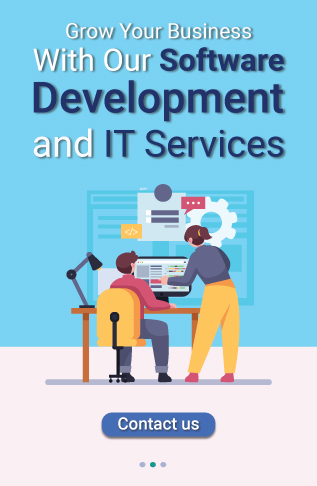Electronic Medical Records refer to a patient’s digital record, which has improved the healthcare industry relatively. They maintain patients’ records in electronic form, eradicating the use of paper to keep records systematized. Due to the adoption of EMRs, doctors can easily obtain the patient’s history faster and more accurately on the EMR. In turn, healthcare software development company provide a platform to assists in decision-making and patient/client care.
EMRs enable users to monitor a patient’s progress and easily share patient information with other healthcare providers. They also help decrease mental mistakes and increase the diagnosis and treatment solution rate. Also, EMRs cut down on clerical work at the doctor’s office and expenses like appointments and billing. Altogether, EMRs positively affect healthcare quality and the execution of various activities related to treatment delivery. Ideally, this change of approach in record keeping is a progressive move regarding health information management and care delivery.
Table of Contents
ToggleAdvantages of EMR Implementation
Let’s look at some of the benefits of implementing EMR in your practice:
- EMRs provide ease of access for healthcare providers, with a single electronic chart that can be accessed from any healthcare facility using EMR software.
- Implementing EMRs can offer financial benefits, including cost savings on office expenditures, improved billing services, and reduced operational costs.
- EMRs allow for better patient care and treatment, with healthcare providers having access to detailed information about a patient’s health history, medications, and allergies.
- EMRs can provide patients with links to educational materials, enabling them to make more informed decisions about their healthcare.
- The ability to quickly transfer patient data between departments is crucial in emergency situations, and patients can easily receive electronic copies of their medical records.
- EMR Software Development can improve healthcare provider communication and lead to more coordinated care.
DreamSoft4u Since 2003
Get your free quote by the top professionals.
Implementing EMR Solution Into Your Practice: Tips and Strategies
The EMR implementation process can be daunting. It is essential to plan carefully to ensure that the transition is as smooth as possible.
Here are some tips and strategies to help you implement an EMR solution into your practice.
1. Conduct a Thorough Need Assessment
It’s critical to evaluate your practice’s requirements before installing an EMR solution. Assess your existing procedures, workflows, and technological infrastructure. Identify EMR features that will best match the particular needs and demands of your practice.
2. Develop a Comprehensive Implementation Plan
To ensure a successful EMR intregation, a thorough implementation plan must be created. The communication should also be clear. It should specify important deadlines, tasks, and milestones. It will ensure that all parties involved, including staff, patients, and vendors, are aware of the implementation process and any potential adjustments.
3. Involve Your Staff in the Implementation Process
Your staff can help you discover potential problems and areas for improvement while also offering insightful information about the day-to-day operations of your practice. Involving your staff in the implementation process also guarantees that everyone is on board with the process.
4. Provide Adequate Training and Support
For your staff to use the EMR technology efficiently, you must provide sufficient training and support. The training should take into account new workflows and procedures that come along with the solution in addition to its technological features. Continuous support is also essential for assisting personnel in overcoming any difficulties that may emerge.
5. Monitor and Evaluate the Implementation Process
Measure the progress over time and determine whether the EMR solution is satisfying your practice’s objectives and requirements. Additionally, it’s critical to get staff and patient input so that the implementation strategy can be modified as necessary. A smooth transition to an EMR solution can be ensured with regular monitoring and optimization of the implementation process.
Techstack for Implementing EMR Solutions
Any Electronic Medical Records solution, irrespective of the scale, must store, retrieve, and process a large amount of patient-provider data. Hence, the tech stack is complex and resource-consuming.
A typical Electronic Medical Records tech stack includes:
- Hardware components such as servers, computers, mobile devices, and
- Software applications like databases, operating systems, and EMR-specific applications.
Cloud-based solutions are becoming increasingly popular for EMR implementation as they offer scalability, accessibility, and cost-effectiveness. Security is also a crucial aspect of the EMR tech stack, with encryption, firewalls, and access control measures being essential to protect patient data.
Healthcare organizations must carefully evaluate their tech stack requirements to ensure that they choose a solution that can effectively manage their data, follow HIPAA guidelines and provide high-quality patient care.
EMR vs EHR
| Feature | EMR (Electronic Medical Records) | EHR (Electronic Health Records) |
| Scope | Detailed records from a single practice | Comprehensive records from multiple sources |
| Interoperability | Limited sharing within one practice | Designed for easy sharing across different providers |
| Purpose | Internal practice management | Comprehensive, patient-centered care across settings |
| Patient Access | Often limited, may require specific requests | Includes patient portals for accessing information |
| Compliance and Reporting | Meets specific internal practice needs | Designed to meet broader regulatory and reporting requirements |
Future of EMR
Enhanced Interoperability: Future EMRs will integrate with other healthcare systems’ integration systems. This means that if you go to different physicians or hospitals, the latter will be able to exchange your personal data. This will result in even more efficient treatment because all records will be accessible to all healthcare workers involved in the patient’s case.
Advanced Analytics: Electronic Medical Record Systems will first incorporate big data and analytics and use artificial intelligence. These tools will enable doctors to find patterns and conclusions with health sector data. For instance, they can perhaps forecast future health problems that may be fatal once they have developed, but with early diagnosis, they can be treated depending on overall health requirements.
Patient Engagement: Newer EMRs will enhance patient engagement with records. New humanized patient portals and mobile applications will help you view, interact with, book, and share your records with your care providers. This will, in turn, assist in simplifying health management and engaging you more in the process.
Improved Data Security: In later EMRs, security is improved to counter increased cyber threats. This means that the information you disclose to your health care provider will be adequately encrypted and secured against any third party’s undue interference, thereby affording you the security that your information is safe from trespassers, among other benefits.
Interconnected Health Ecosystems: Similar to what has been projected above, EMRs will continue to be incorporated with other health technologies, such as wearable fitness tracker devices and telehealth services. This integration will enable all health data to be linked and passed across different applications with enhanced coordination of all healthcare providers.
Automation and Efficiency: In the future, most of the activities related to managing EMRs will be performed with software’s assistance. It includes activities such as typing and combining data, among others. Utlizing these benefits of EMR will change and free up time previously wasted on other administrative tasks, giving more time for healthcare and efficiency in the practice.
Customization and Flexibility: Future EMRs will be more customizable to fit the specific needs of different healthcare practices. EMRs can adapt to various workflows and specialities, whether a small clinic or a large hospital. This flexibility will help practices use the system more effectively and meet their unique operational needs.
Want to integrate EMR system in your healthcare app?
DreamSoft4u, Your True Healthcare Partner.
Conclusion
EMRs provide benefits to the healthcare industry in many ways. They facilitate patient data organization, integration, acquisition, and utilization while at the same time increasing the quality of care. Aimed at increasing information control amongst healthcare givers, EMRs contribute to enhancing interprofessional working relationships to develop improved, effective, and efficient operational strategies. They also enhance patients’ satisfaction standards and help to decrease overall costs because they decrease paperwork and administrative workloads. Thus, the EMRs will also advance due to ongoing technological enhancements and provide an even better opportunity to improve the accessibility, quality, and cost of healthcare.
FAQs
Q1. How do Electronic Medical Records increase efficiency in healthcare?
EMRs can streamline administrative tasks, such as scheduling appointments and billing, and allow healthcare providers to quickly access patient information.
Q2. How do EMRs improve patient care?
EMRs provide quick access to patient histories, allowing healthcare providers to make better-informed decisions, offer personalized treatments, and coordinate care more effectively.
Q3. What are the benefits of EMRs for healthcare providers?
EMRs help providers by reducing paperwork, streamlining administrative tasks, improving efficiency, and enabling better communication with other healthcare professionals.
Q4. Are EMRs secure?
Yes, EMRs use encryption and other security measures to protect patient information. They are designed to comply with privacy regulations and ensure that sensitive data is kept safe from unauthorized access.
Q5. How do EMRs benefit patients directly?
Patients benefit from EMRs through easier access to their health information, better coordination of care between different providers, and potentially quicker diagnosis and treatment due to streamlined data sharing.























